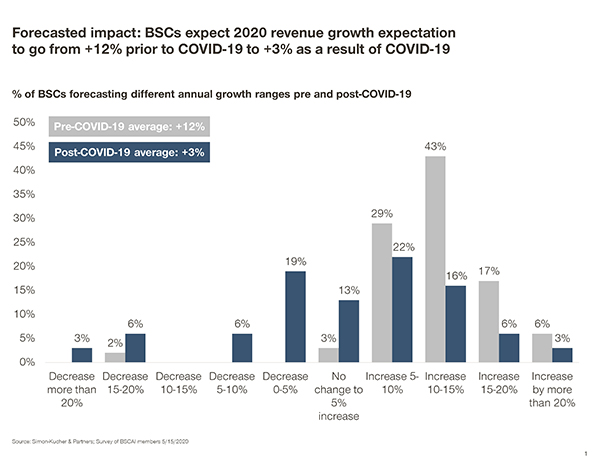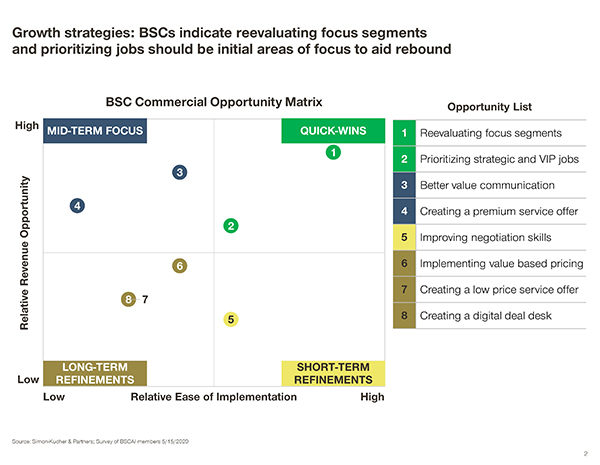COVID-19 has brought rapid and significant changes to the building services industry, exacerbating labor shortages, forcing companies to quickly adjust offerings, and bringing uncertainty to demand forecasts. A recent survey of building service contractors (BSCs) conducted by strategy consulting firm Simon-Kucher & Partners and Building Services Contractors Association International (BSCAI) indicates that COVID-19 has dampened expectations for 2020 revenue growth from ~12% to ~3% (see Figure 1).

Figure 1: Distribution of pre- and post-COVID-19 expected revenue growth rates among building service contractors (Courtesy of BSCAI/Simon-Kucher & Partners)
With this dynamic business environment and an opportunity for a commercial reset, thinking systematically about how to drive revenue growth in both the short-term and long-term is critical.
In the short-term
Focus on the right customers
In times of uncertainty, fall back on providing great service to your best customers and spend energy on the appropriate segments.
- Focus on key accounts first—Ensure that you define who these customers are, understand how their needs may have recently changed, and create long-term loyalty.
- Consider how to better serve your customers without compromising price—Offering better payment terms and 24-hour service, and freezing fees and less favorable contract terms are all options.
- Think comprehensively about the types of customers you target—Identify which segments are most attractive (e.g., industry vertical, size, competitiveness, willingness to pay) and best align with your capabilities.
Differentiate your service offering
Design your service offer based on what your customers value and what they’re willing to pay.
- Refine your offer—Needs-specific packages or tiered offerings can improve the sales conversation by creating options that are tailored to specific customer types.
- Add a premium offer—Not all customers need a premium offering but those who do are willing to pay for it. Don’t let these profitable customers go to your competitors because you don’t have a higher-value service.
- Never reduce price without reducing service level—Remove noncore elements of your service from less expensive offerings to target customers with higher price sensitivity; don’t simply drop price.
Prioritize strategic projects
Think critically about which jobs are most desirable and allocate resources accordingly.
- Define what strategic importance means to you—Identify the industries, service types, and customer types you want to prioritize.
- Not all projects warrant the same attention—Based on your available capacity, deprioritize small projects that don’t offer a clear long-term advantage.
- Match negotiating strategy to project importance—First, offer concessions that are inexpensive and less important to you. Reserve costly concessions for strategic accounts and concede on price last, if at all.
In the long-term
Refine your value proposition and communication
Understand and clearly communicate your value proposition to customers and prospects alike.
- Understand how value drivers change by segment and communicate them in a differentiated way—Define key buying criteria by segment and have a plan for articulating your performance on the most important criteria.
- Demonstrate your value by focusing on results—Don’t just talk about your service quality, qualified and well-trained staff, and scheduling availability. Talk about how you provide your customers with higher levels of safety, peace of mind, and reduced hassle as a result.
- Prove your claims—Leverage certifications, service trials, customer satisfaction data, company track record, warranties, or customer testimonials to build trust.
Optimize your price model
Building services is a cost-intensive industry; pricing is a key lever for profitability.
- Adjust prices based on your price-value relationship—Understand the value you offer relative to your competitors. Set prices based on the value you deliver rather than cost.
- Differentiate your pricing—Charge differently for different job-types and service occasions where willingness to pay differs (e.g., across regions, verticals, service frequencies). Don’t forget to monetize noncore services that add significant value (e.g., disinfecting, weekend service).
Build your digital selling capability
Increasingly digital-savvy customers have been shifting their buying habits for years. Your sales process should match these purchasing trends.
- Become proficient in multichannel sales—Design a seamless multichannel sales experience across both physical (sales calls/visits, mailings) and digital (social media, website, email) touchpoints.
- Support sales teams with modern methods—Increase sales efficiency by enabling data-driven sales and digitizing opportunity-to-order processes to reduce cycle times for quotes.
- Manage change appropriately to succeed—Foster a digital-savvy culture among your teams and enable them to make the transition to digital.
A path forward
While there is considerable uncertainty in these turbulent times, BSCs have an opportunity to drive meaningful organizational improvement. Based on feedback Simon-Kucher & Partners received from BSCs (see Figure 2), below are a few focus strategies to consider prioritizing based on revenue potential and ease of implementation.

Figure 2: Revenue impact and ease of implementation of several revenue growth strategies (Courtesy of BSCAI/Simon-Kucher & Partners)
Begin with “quick wins” and “short-term refinements” by reevaluating your focus segments, prioritizing strategic jobs, and improving negotiation skills. Follow up with the “mid-term focuses”—improve value communication and create a premium service offer. Lastly, move on to the “long-term refinements” to realize additional impact.
Combined, each opportunity is a key component of a bullet-proof strategy to grow revenue and help your business thrive during the COVID-19 rebound and beyond.






